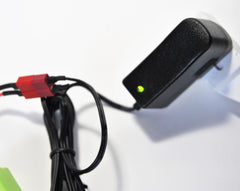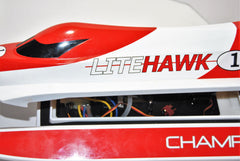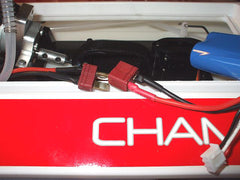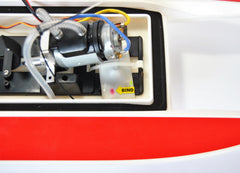CHAMP FAQ
|
Welcome to our FAQ area for LiteHawk CHAMP. Simple tips and tricks are just below - check our Overview video for even more info! Still have a question? Please contact us using the links at the bottom of the page. |

|
|
LiteHawk CHAMP - Operational Range
The range of your boat is approximately 250ft which, due to its small size, is in excess of normal vision. The farther the boat goes away from you the smaller it will become and the harder it will be to determine the boat’s direction We suggest you drive at a distance between 20ft-50ft, this keeps your boat within a safe operational distance.
LiteHawk CHAMP - Basic Boat Terminology
- Bow: The front of the boat. - Stern: The back of the boat. - Port: This is the left side of the boat when you are facing the bow of the boat. An easy way to remember this is that port and left both contain four letters. - Starboard: This is the right side of the boat when you are facing the bow of the boat. - Hull: The body of the boat. - Deck: The top of the boat. |
|
LiteHawk CHAMP - NIMH Battery and Charger Instructions: STEP 1: Remove the wall plug charger from the package and plug it into the wall. When plugged in a green LED light will come on. STEP 2: Connect the NIMH battery to the charger. The green LED light will turn to red. STEP 3: When the LED indicator light on the charger turns back to green, the battery is fully charged. Charge times are (approx. 2 hrs) do not leave on charge overnight. Battery should be unplugged from the charger after a maximum 3 hours. STEP 4: Unplug the battery from the charger and remove the charger from the wall plug. During charging: |
| LiteHawk CHAMP - Charging the 7.4V Li-Ion Battery - The 7.4V battery and charger will get warm while charging. This is normal. Do not charge on, or near to, a material or surface that is flammable or one that can be damaged by heat. - The 7.4V battery can be re-charged many times before it needs replacing. When the 7.4V battery no longer holds a charge it should be properly recycled. DO NOT THROW IN HOUSEHOLD WASTE! - Your LiteHawk CHAMP will typically run for around 8 minutes on a fully charged 7.4V battery. As soon as you notice a drop off in speed you should bring the model back to shore or control may be lost. |
|
|
LiteHawk CHAMP - Deck Removal 1/ Turn both the hold downs located at the rear of the boat to the side. |
  |
LiteHawk CHAMP - Installing the Battery. Both the Li-Ion and the Nimh install the same way. 1/ Remove the LiteHawk CHAMP upper deck by rotating the hold downs on both the left and right side. Slide/Tilt the canopy up. 2/ Insert the battery into the boat hull. There is a Velcro strap to hold the battery in place. 3/ Attach the battery connector to the matching connector in the LiteHawk CHAMP. Do not force them together – they only attach one way! 4/ Re-position the cowl securely and re-fit the hold downs in place. Notes: - There is a waterproof rubber gasket inserted into the lip where the hull joins the main upper deck. Always make sure it’s secured and in position before re installing the upper deck. - Remember to disconnect the battery and remove it after use. Always recharge the battery if you intend on storing the boat for more than 24 hours - failure to do so will result in damage to the battery pack. |
|
|
LiteHawk CHAMP - Binding the Boat with Radio 1/ Turn the radio on before plugging in the battery. 2/ Plug battery in. 3/ Out of the box, the Champ should bind with no problem. Green LED light on receiver will glow. If it does not bind, turn on radio, plug battery in, hold down the "BIND" button on the receiver. The green LED light will turn on, confirming it is bound. |
 |
LiteHawk CHAMP - Water-cooled and water-proof electronics: All LiteHawk Marine items are water-cooled! Your LiteHawk CHAMP picks up water with a steel pickup tube,at the rudder, as the boat is moving through the water. The water is first forced through the Receiver and Electronic Speed Control (ESC), then moves through a water-cooled motor mount. This helps to keep your motor cool. Then the hot... cooling water leaves the boat at the rear of the hull. All this protection helps to avoid the classic problem that all R/C power boats have - how to keep everything cool. - Before using your new boat carefully check that the silicone cooling tubes are connected securely and not blocked, or kinked. Ensure that the water inlet at the rudder is not obstructed. A good way to check for blockages is to use your mouth to blow air into the outlet tube and make sure you have air exiting the inlet at the rudder. - If you are running the boat in salt water, than you should blow out the cooling system as mentioned above after use. If possible run in fresh water for a minute or so to flush the lines. |
 |
LiteHawk CHAMP - Changing Propeller Not moving as fast? A damaged prop may be the answer. Lets see how to change it. 1/ Locate the nut at the back of the boat holding the propeller on. 2/ While holding the propeller use a pair of pliers to loosen the nut, or a 5.5mm box end or socket wrench. One comes with LiteHawk's Ground Vehicles for removing wheels. 3/ Once removed, slide the propeller off and replace it with the new one. 4/ Make sure to line the propeller up so it locks into place properly. 5/ Securely hold the propeller and tighten the nut back on. |
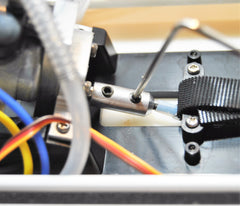 
|
LiteHawk CHAMP - Flex Shaft Maintenance/Removal Lubricating the flex shaft is vital to the life of the drive train. The lubricant also acts as a water seal, keeping water from entering the hull through the stuffing tube. Lubricate the flex shaft and propeller shaft after every 2-3 times that you operate your LiteHawk CHAMP. 1/ When you look inside the boat you will notice a silver coupling attaching the motor set-up to the flex shaft. 2/ With the included hex keys loosen the hex screws gripping the flex shaft . 3/ There are three hex screws, loosen the two towards the back of the boat, these two hold the flex shaft.. the other hex screw holds the coupler to the motor shaft. 4/ First remove the Propeller from the flex shaft, then loosen the two hex screws holding the flex shaft to the coupler, now you can pull the flex shaft out the back of the boat. 5/ Once exposed you can apply a small amount of grease to keep it in smooth running condition. 6/ Simply push back in and tighten up the hex screws when done, and reinstall the prop. |
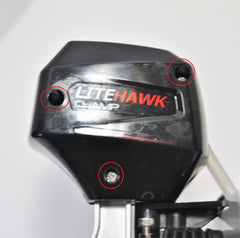    
|
LiteHawk CHAMP - How To Replace The Rudder 1/ Remove the three screws in the rudder case to get access to the water line . |
 
|
LiteHawk CHAMP - Servo/Rudder Linkage 4/Reassemble in reverse order. Put the Servo arm in the neutral position ( straight up and down ) and slide the wire through its mounting hole on the rudder. Move the rudder until it is straight and tighten the hex screw down on the servo wire. |



